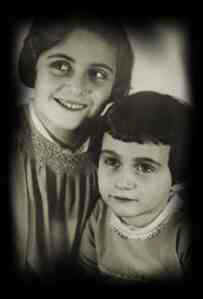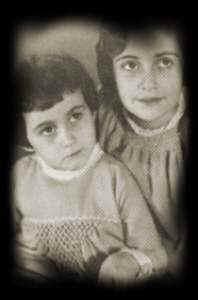
Anne Frank

"We're much too young to deal with these problems, but they keep thrusting themselves on us until, finally, we're forced to think up a solution, though most of the time our solutions crumble when faced with the facts. It's difficult in times like these: ideals, dreams and cherished hopes rise within us, only to be crushed by grim reality. It's a wonder I haven't abandoned all my ideals, they seem so absurd and impractical. Yet I cling to them because I still believe, in spite of everything, that people are truly good at heart.
"...And yet, when I look up at the sky, I somehow feel that everything will change for the better, that this cruelty too shall end, that peace and tranquility will return once more. In the meantime, I must hold on to my ideals. Perhaps the day will come when I'll be able to realize them!
– From Anne's diary, July 15, 1944



Anne Frank and her sister Margot
Anne Frank; Her life & Times:
Born on June 12,
1929, Anne Frank was a German-Jewish teenager who was forced to go into hiding
during the Holocaust. She and her family, along with four others, spent 25
months during World War II in an annex of rooms above her father’s office in
Amsterdam, the Netherlands.
After being betrayed to the Nazis, Anne, her family, and the others living with
them were arrested and deported to Nazi concentration camps. Nine months after
she was arrested, Anne Frank died of typhus in March of 1945 at Bergen-Belsen.
She was fifteen years old.
Her diary, saved during the war by one of the family’s helpers, Miep Gies, was first published in 1947. Today, her diary has been translated into 67 languages and is one of the most widely read books in the world.


Margot and Anne
 Anne
Frank was one of the Jewish victims of Nazi persecution during the second world
war. After Nazi Germany invaded the Netherlands in 1940, increasingly severe
anti-Jewish measures began here as well. The Frank family tried to escape by
going into hiding. On July 1942, Otto Frank, Edith Frank-Hollander and their
daughters Margot and Anne hid in this building on the Prinsengracht. They where
later joined by Mr. and Mrs Daan, their sun Peter and Mr. Dussel. The building
consists of two parts : a front house and a back anex. Otto Frank's business was
located in the front house. The uppermost floors of the back anexe became the
hiding place. After more than two years the group was betrayed and deported.
Anne and Margot died of typhus in Bergen-Belsen in March 1945, only a few weeks
before this concentration camp was liberated. Otto Frank, the only member of the
group to survive, returned after the war.
Anne
Frank was one of the Jewish victims of Nazi persecution during the second world
war. After Nazi Germany invaded the Netherlands in 1940, increasingly severe
anti-Jewish measures began here as well. The Frank family tried to escape by
going into hiding. On July 1942, Otto Frank, Edith Frank-Hollander and their
daughters Margot and Anne hid in this building on the Prinsengracht. They where
later joined by Mr. and Mrs Daan, their sun Peter and Mr. Dussel. The building
consists of two parts : a front house and a back anex. Otto Frank's business was
located in the front house. The uppermost floors of the back anexe became the
hiding place. After more than two years the group was betrayed and deported.
Anne and Margot died of typhus in Bergen-Belsen in March 1945, only a few weeks
before this concentration camp was liberated. Otto Frank, the only member of the
group to survive, returned after the war.
During the hiding period Anne Frank kept a diary. In it she described daily life, the isolation and the fear of discovery. Anne's diary survived the war: after the betrayal it was found by Miep Gies, one of the helpers. When it was confirmed that Anne would not be returning, Miep gave the manuscripts to Otto Frank. In 1947 the first Dutch edition appeared.
TIMELINE OF IMPORTANT DATES:
May 12, 1889: Otto
Frank (Anne‘s father), is born in Frankfurt am Main, Germany.
April 20, 1889: Adolph Hitler is born in Austria.
January 16, 1900: Edith Holl"nder (Anne’s mother), is born in Aachen,
Germany.
1914-1918: Otto Frank serves in German Army during WWI as a lieutenant. Adolph
Hitler also serves from 1914-1920, as a Corporal.
November 11, 1918: The Armistice which ends World War I is signed.
June 23, 1919: Germany accepts the Versailles Treaty.
April 1, 1920: Hitler joins the Nationalist Socialist German Worker’s Party.
January 1923: The National Socialist German Workers’ Party (Nationalsozialistische
Deutsch Arbeiterpartei), known as the Nazi Party, holds its first rally in
Munich.
May 12, 1925: Otto Frank and Edith Holl"nder are married in Achen, Germany.
July 1925: Mein Kampf, Hilter’s autobiography and anti-Semitic plan, is
published.
February 16, 1926: The Franks’ first daughter, Margot, is born in Frankfurt am
Maim, Germany.
June 12, 1929: The Franks’ second daughter, Anneliese Marie or Anne, is born
in Frankfurt am Maim, Germany.
July 31, 1932: The Nazis receive 37.4 percent of the vote and are asked to form
a coalition government.
January 30, 1933: Hitler is appointed Chancellor of Germany.
February 1933: Freedom of speech and assembly is suspended by the Nazi
government.
March 1933: The Gestapo, or Secret State Police, is established. Dachau, the
main concentration camp for political prisoners, is built.
April 1933: The Nazis declare a boycott of Jewish businesses and medical and
legal practices. A law excluding non-Aryans removes Jews from government and
teaching positions.
May 10, 1933: Books by Jews, political enemies of the Nazi state, and other
"undesirables" are burned in huge rallies throughout Germany.
Summer 1933: The Franks decide that the family must move to the Netherlands
because of increasing tensions in Germany. Edith, Margot and Anne Frank join
Grandmother Hollander in Aachen. Otto Frank travels to Holland.
July 1933: Hitler bans all political parties except for the Nazi Party.
September 15, 1933: Otto Frank establishes his firm Opekta Werke in Amsterdam.
October 1933: Alice Frank-Stern, Anne’s paternal grandmother, moves to Basel
in Switzerland.
December 5 1933: Edith and Margot Frank move to Holland.
January 1934: Forced sterilization of the racially "inferior,"
primarily Gypsies and African-Germans, and the "unfit," the mentally
and physically disabled, begins.
February 1934: Anne Frank joins them in Holland.
1934: Anne Frank attends the kindergarten of the Montessori School.
Fall 1935: The Nuremberg Laws are passed defining Jews as noncitizens and making
mixed Aryan and Jewish marriage illegal.
March 7, 1936: Germans march into the Rhineland, violating the Versailles
Treaty.
Summer 1936: Olympic games are held in Berlin, Germany. The United States
participates.
Summer 1937: The van Pels familyl flees from Osnabruck to Holland.
March 12, 1938: Germany annexes Austria.
November 9-10, 1938: Kristallnacht. State-sponsored pogrom in Germany and
Austria, looting and destroying synagogues and Jewish owned-businesses.
December 8, 1938: Fritz Pfeffer flees Germany and arrives in Holland.
March 15, 1939: Germany occupies Czechoslovakia.
March 1939: Grandmother Hollander comes to live the the Frank family.
September 1, 1939: Hitler invades Poland and starts the beginning of World War
II
September 1939: "Tiergarten 4." Hitler implements the T-4 Program,
killing the institutionalized, physically disabled, and mentally handicapped.
April and May 1940: Germany invades Denmark and Norway, the Netherlands, France,
Belgium, and Luxembourg.
December 1, 1940: Otto Frank’s company moves into the premises at number 263
Prinsengracht.
May 8, 1941: Opekta-Werke changes its name to Messrs. Gies & Company.
Summer 1941: Anne and Margot attend the Jewish School Amsterdam.
December 11, 1941: Germany declares war on the United States.
January 1942: Death of Grandmother Hollander.
March 1942: Sobibor, Belzec, and Auschwitz-Birkenau all become fully operational
death camps, followed by Treblinka in July.
June 12, 1942: Anne receives a diary for her thirteenth birthday.
July 5, 1942: Margot receives a call-up notice to report for deportation to a
labor camp. The family goes into hiding the next day.
July 6, 1942: The Frank family moves into the "Secret Annex".
July 13, 1942: The van Pels family, another Jewish family originally from
Germany, joins the Frank family in hiding.
November 16, 1942: Fritz Pfeffer, the eighth and final resident of the Secret
Annex, joins the Frank and van Pels families.
February 2, 1943: The advance of the German Army into the Soviet Union is halted
at the city of Stalingrad in the Soviet Union. The tide of the war begins to
turn against Germany.
June 1943: SS leader Himmler orders the "liquidation" of all the
ghettos in Poland and the Soviet Union to death camps.
June 6, 1944: D Day. Allies invade Western Europe.
August 4, 1944: The residents of the Secret Annex are betrayed and arrested.
They are taken to a police station in Amsterdam and eventually to the Westerbork
transit camp.
August 8, 1944: They are all taken to the camp at Westerbork.
September 3, 1944: The eight prisoners are transported in a sealed cattle car to
Auschwitz, on the last transport ever to leave Westerbork. Hermann van Pels is
gassed on September 6, 1944.
October 6, 1944: Anne and Margot Frank are sent to Bergen-Belsen concentration
camp in Germany.
November 26, 1944: Himmler orders troops to destroy the crematoria at Auschwitz
to hide the Nazi war crimes.
December 20, 1944: Fritz Pfeffer dies in Neuengame.
January 6, 1945: Edith Frank dies at Auschwitz-Birkenau.
January 27, 1945: Otto Frank is liberated from Auschwitz by the Russian Army. He
is taken first to Odessa and then to France before he is allowed to make his way
back to Amsterdam.
February or March 1945: Anne and Margot Frank die at the Bergen-Belsen
concentration camp within days of each other.
April 30, 1945: Adolph Hitler commits suicide.
May 1945: Peter van Pels dies in Mauthausen.
May 7, 1945: Germany surrenders, and the war ends in Europe.
Spring 1945: Mrs. van Pels dies in Theresienstadt concentration camp in
Czechoslovakia.
June 3, 1945: Otto Frank arrives in Amsterdam, where he is reunited with Miep
and Jan Gies. He concentrates on finding the whereabouts of Anne and Margot.
October 24, 1945: Otto Frank receives a letter telling him that his daughters
died at Bergen-Belsen.
November 1945: The Nuremberg Trials of Nazi war criminals begin.
April 3, 1946: An article in Het Parool discusses Anne’s diary.
Summer 1947: 1,500 copies of Anne’s diary are published by Contact Publishers
in Amsterdam.
1951: The diary is translated into English.
1954: The Dutch Red Cross officially declares that Anne and Margot died at
Bergen-Belsen in 1945.
May 1960: The Anne Frank House opens.
August 19, 1980: Otto Frank dies in Birsfelden, Switzerland. He is 91